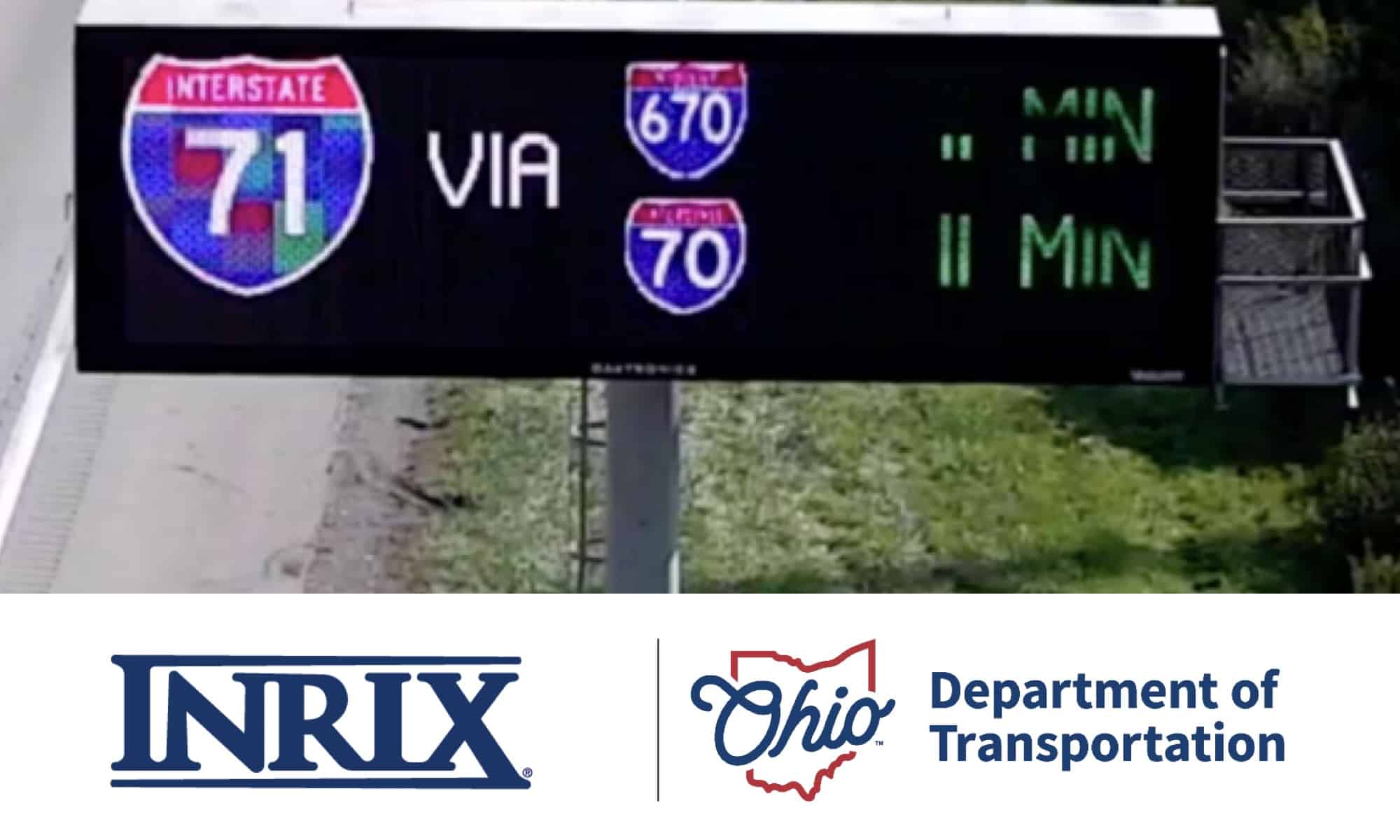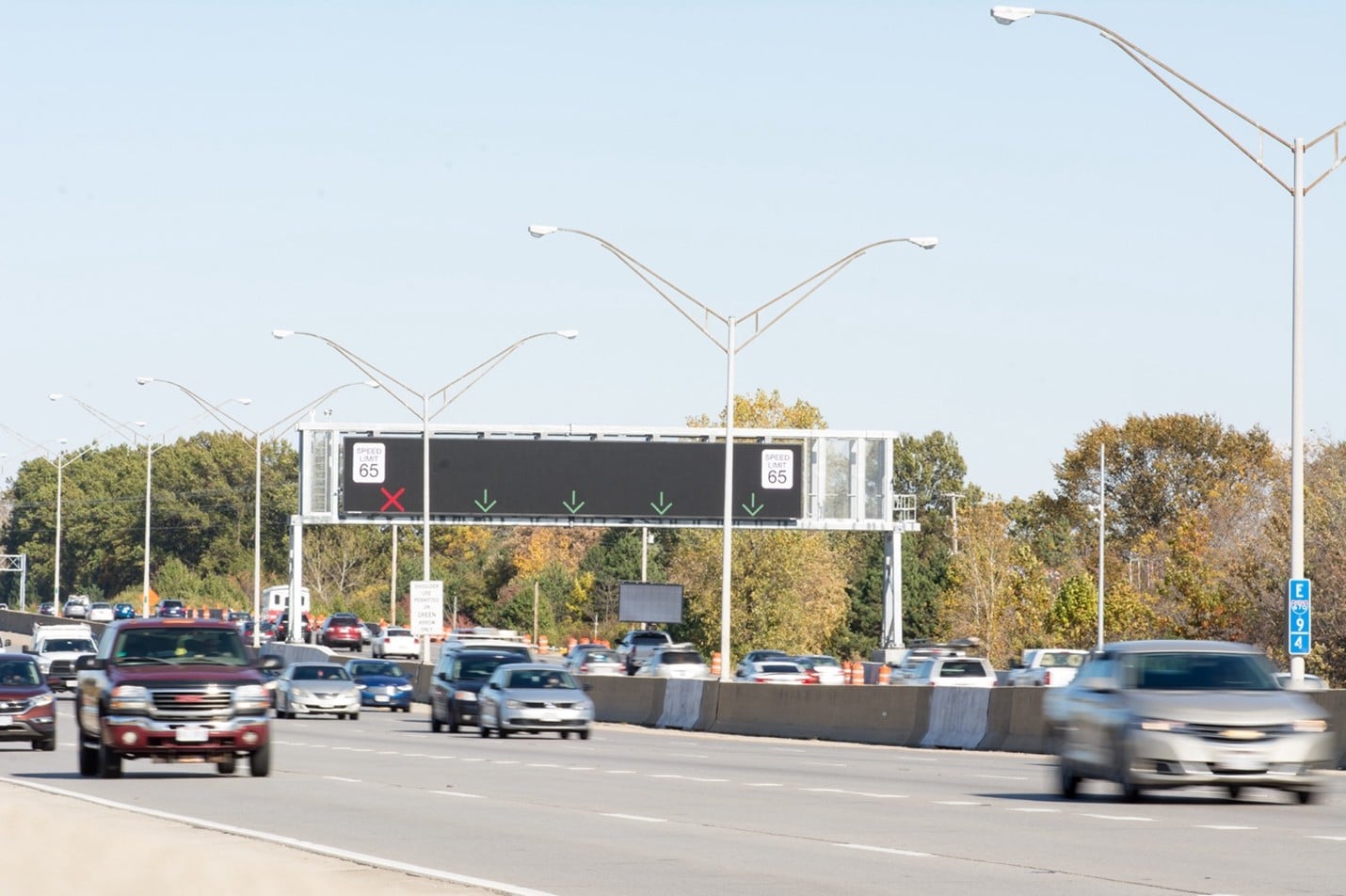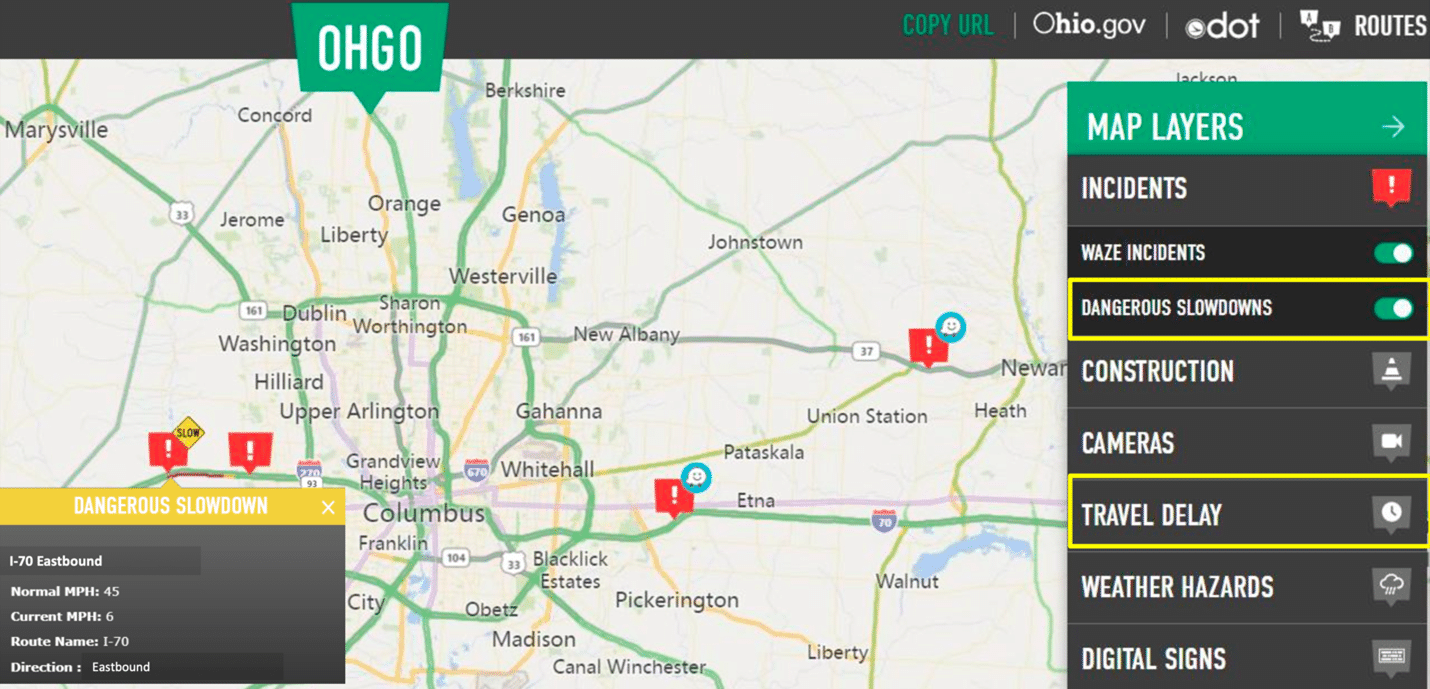
When transportation agencies first began sharing real-time traveler information, a roadside message board was often the only way to reach drivers.
Today, the Ohio Department of Transportation (ODOT) demonstrates how agencies can deliver increasingly personalized real-time traffic alerts – from regional broadcasts to targeted in-vehicle notifications. This post explores ODOT’s traveler information across a few layers:
- Regionally
- Corridor-Level
- Personalized/ Route-Level
- Vehicle-Specific
Regional Awareness: The Foundation
At the broadest level, ODOT maintains a network of over 180 Dynamic Message Signs (DMS) across Ohio’s roadways. These signs serve as the first line of communication, displaying real-time travel times and critical alerts to all passing motorists. While this traditional approach remains valuable for reaching large volumes of travelers, it’s just the beginning of ODOT’s multi-layered information strategy.
Corridor-Level Intelligence
ODOT has elevated real-time information delivery along specific high-priority corridors through specialized systems. These corridor-specific solutions represent a more targeted approach than regional messaging, allowing ODOT to address unique challenges along particular stretches of roadway.
Smart Lanes
On corridors like I-275 in Cincinnati and I-670 in Columbus, ODOT combines real-time data with dynamic lane management. When congestion builds, operators can open shoulder lanes while using overhead signs to communicate changing traffic patterns to drivers in real-time. This corridor-level active traffic management provides another layer of regional specificity and control for ODOT.

Queue Warning Systems
In areas with frequent bottlenecks, ODOT’s queue warning systems leverages data to identify and warn approaching drivers about sudden changes in traffic conditions. This proactive system helps prevent secondary crashes by alerting drivers before they encounter stopped traffic. The department has selected a handful of most dangerous slowdown locations across the state, using INRIX data to strategically locate this critical infrastructure. Additionally, ODOT is piloting the integration of INRIX’s real-time dangerous slowdown detection feed into the Statewide Traffic Management Center’s (TMC) Advanced Traffic Management System (ATMS) to help detect queues without physical infrastructure.

Variable Speed Corridors
Along I-90 in northeast Ohio, ODOT’s variable speed limit system helps operators make informed decisions about speed adjustments due to unpredictable lake-effect snow storms. Through the ATMS, TMC specialists monitor weather data, from Road Weather Information Systems (RWIS), and speed data via on-site sensors and INRIX’s segment-by-segment speed data to identify developing hazardous conditions and adjust speed limits accordingly, ensuring drivers receive updated speed guidance before encountering slowdowns.

Route-Specific Information
Through the OHGO platform, ODOT has enhanced how travelers receive customized traffic information that matters most to their specific trips. At the heart of this system is INRIX’s real-time data, which powers several critical features. The platform calculates precise travel delays by continuously monitoring traffic conditions along each user’s route, ensuring travelers always have the most current information for their trip planning. When sudden slowdowns occur, the system immediately generates targeted personalized alerts, helping travelers avoid unexpected delays. These alerts are complemented by real-time travel delay estimates that update as conditions change.
Beyond these INRIX-powered features, OHGO enriches its user experience by integrating additional data sources. Construction impacts are carefully tracked and communicated, helping travelers plan around road work. Incident alerts provide immediate notification of ODOT-verified traffic incidents, while weather-related delays help travelers understand how current conditions might affect their journey.
The OHGO mobile app takes this personalization even further, delivering a suite of mobile-friendly alerts powered by INRIX data. When dangerous slowdowns develop ahead, or incidents along a drivers personalized route, the app provides timely push notifications to help the driver avoid the dangerous conditions. Real-time travel delays are communicated through intuitive interfaces, while the hands-free audio alert feature ensures drivers can stay informed without taking their eyes off the road. The app’s location-based notification system constantly monitors the user’s position to deliver relevant alerts at exactly the right moment.

Vehicle-Specific Solutions
At the most targeted level, ODOT has developed sophisticated systems to deliver personalized alerts directly to individual vehicles. This cutting-edge approach is made possible through strategic partnerships with INRIX, Drivewyze, and Information Logistics (ILOG), each bringing unique capabilities to create a next-generation in-vehicle alerting ecosystem.
Commercial Vehicle Safety
The commercial vehicle safety program represents one of ODOT’s most advanced applications of targeted information delivery. Through a groundbreaking partnership with INRIX and Drivewyze, ODOT has implemented a Vehicle-to-Network (V2N) alerting system that delivers precisely timed safety alerts directly into commercial vehicle cabs. These alerts are powered by INRIX’s sophisticated real-time data feeds, which continuously monitor live traffic conditions across Ohio’s highway network.
The system generates thousands of targeted notifications each month, with each alert carefully crafted to provide maximum value to commercial drivers. When INRIX’s algorithms detect dangerous slowdowns ahead, the system immediately alerts approaching truck drivers, giving them extra time to safely reduce speed. The end-of-queue warning system helps prevent one of the most dangerous scenarios in commercial vehicle operations – unexpected encounters with stopped traffic. Additionally, ODOT sends work zone alerts ensure drivers are well-informed about construction activities ahead, allowing them to prepare for changing traffic patterns.
What makes this system particularly effective is its precision – each alert is carefully timed and located to give drivers adequate warning while maintaining relevance to their specific situation. This targeted approach helps prevent alert fatigue while ensuring drivers receive the critical information they need exactly when they need it.

Emergency Alerts (ILOG HELP)
ODOT uses the ILOG HELP system, with INRIX data integrated, to help operators visualize traffic impacts when defining emergency alert areas. Operators draw a polygon around an area affected by a traffic emergency, and the system then:
- Sends Wireless Emergency Alerts to the cell phones of motorists within the affected area
- Opens two-way communication channels with stranded drivers
- Warns approaching vehicles to avoid dangerous conditions
- Helps operators adjust the alert area based on real-time traffic patterns
Impact
This layered approach to information delivery ensures that whether you’re one of thousands passing a DMS board or a single truck driver receiving a targeted queue warning, you get the real-time traveler information you need in the most effective format. As ODOT continues to explore enhanced connected vehicle and traveler information applications, this personalized approach will become even more sophisticated.
ODOT’s evolution in traveler information delivery demonstrates how agencies can move beyond one-size-fits-all solutions to create an ecosystem of complementary communication channels, each serving specific needs and user groups.
Want to learn more about ODOT’s real-time information systems? Visit OHGO.com to see many of these solutions in action.
Interested in using real-time INRIX data for your agency? Contact us at sales@inrix.com or visit inrix.com/products/traffic to learn more.




